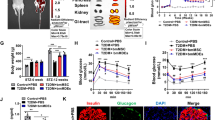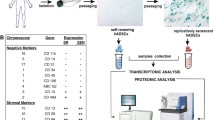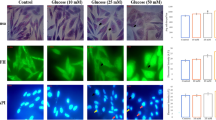Abstract
Intracellular metabolic reprogramming is a critical process the cells carry out to increase biomass, energy fulfillment and genome replication. Cells reprogram their demands from internal catabolic or anabolic activities in coordination with multiple genes and microRNAs which further control the critical processes of differentiation and proliferation. The microRNAs reprogram the metabolism involving mitochondria, the nucleus and the biochemical processes utilizing glucose, amino acids, lipids, and nucleic acids resulting in ATP production. The processes of glycolysis, tricarboxylic acid cycle, or oxidative phosphorylation are also mediated by micro-RNAs maintaining cells and organs in a non-diseased state. Several reports have shown practical applications of metabolic reprogramming for clinical utility to assess various diseases, mostly studying cancer and immune-related disorders. Cells under diseased conditions utilize glycolysis for abnormal growth or proliferation, respectively, affecting mitochondrial paucity and biogenesis. Similar metabolic processes also affect gene expressions and transcriptional regulation for carrying out biochemical reactions. Metabolic reprogramming is equally vital for regulating cell environment to maintain organs and tissues in non-diseased states. This review offers in depth insights and analysis of how miRNAs regulate metabolic reprogramming in four major types of cells undergoing differentiation and proliferation, i.e., immune cells, neuronal cells, skeletal satellite cells, and cardiomyocytes under a non-diseased state. Further, the work systematically summarizes and elaborates regulation of genetic switches by microRNAs through predominantly through cellular reprogramming and metabolic processes for the first time. The observations will lead to a better understanding of disease initiation during the differentiation and proliferation stages of cells, as well as fresh approaches to studying clinical onset of linked metabolic diseases targeting metabolic processes.

Similar content being viewed by others
References
Ward PS, Thompson CB (2012) Metabolic reprogramming: a cancer hallmark even warburg did not anticipate. Cancer Cell 21:297–308
Ryall JG, Cliff T, Dalton S, Sartorelli V (2015) Metabolic reprogramming of stem cell epigenetics. Cell Stem Cell 17:651–662
Ha M, Kim VN (2014) Regulation of microRNA biogenesis. Nat Rev Mol Cell Biol 15:509–524
Stincone A, Prigione A, Cramer T et al (2015) The return of metabolism: biochemistry and physiology of the pentose phosphate pathway. Biol Rev 90:927–963. https://doi.org/10.1111/brv.12140
Jiang P, Du W, Wu M (2014) Regulation of the pentose phosphate pathway in cancer. Protein Cell. https://doi.org/10.1007/s13238-014-0082-8
van den Bossche J, Saraber DL (2018) Metabolic regulation of macrophages in tissues. Cell Immunol 330:54–59. https://doi.org/10.1016/j.cellimm.2018.01.009
Lee H-Y, Hong I-S (2020) Metabolic regulation and related molecular mechanisms in various stem cell functions. Curr Stem Cell Res Ther 15:531–546. https://doi.org/10.2174/1574888x15666200512105347
Contemporary Metabolism: Volume 2 - Norbert Freinkel - Google Books
Lunt SY, vander Heiden MG (2011) Aerobic glycolysis: meeting the metabolic requirements of cell proliferation. Annu Rev Cell Dev Biol 27:441–464. https://doi.org/10.1146/annurev-cellbio-092910-154237
Miller MA, Zachary JF (2017) Mechanisms and morphology of cellular injury, adaptation, and death. In: Pathologic Basis of Veterinary Disease Expert Consult. Elsevier Inc., pp. 2–43.e19
Chandel NS (2021) Signaling and metabolism. Cold Spring Harb Perspect Biol 13:1–20. https://doi.org/10.1101/cshperspect.a040600
Ward PS, Thompson CB (2012) Signaling in control of cell growth and metabolism. Cold Spring Harb Perspect Biol. https://doi.org/10.1101/cshperspect.a006783
Metallo CM, vander Heiden MG (2013) Understanding metabolic regulation and its influence on cell physiology. Mol Cell 49:388–398
Xue J, Schmidt SV, Sander J et al (2014) Transcriptome-based network analysis reveals a spectrum model of human macrophage activation. Immunity 40:274–288. https://doi.org/10.1016/j.immuni.2014.01.006
Colamatteo A, Micillo T, Bruzzaniti S et al (2019) Metabolism and autoimmune responses: the microRNA connection. Front Immunol 10:1969
Chawla A (2010) Control of macrophage activation and function by PPARs. Circ Res 106:1559–1569
O’Neill L, Nature DH (2013) Undefined Metabolism of inflammation limited by AMPK and pseudo-starvation. Nature 493:346–355
Cantó C, Gerhart-Hines Z, Feige J et al (2009) AMPK regulates energy expenditure by modulating NAD+ metabolism and SIRT1 activity. Nature 458(7241):1056–1060
Soñanez-Organis J, Biochimie MRA (2012) Undefined alternative splicing generates two lactate dehydrogenase subunits differentially expressed during hypoxia via HIF-1 in the shrimp Litopenaeus vannamei. Elsevier
Ullah MS, Davies AJ, Halestrap AP (2006) The plasma membrane lactate transporter MCT4, but not MCT1, is up-regulated by hypoxia through a HIF-1α-dependent mechanism. J Biol Chem 281:9030–9037. https://doi.org/10.1074/jbc.M511397200
van den Bossche J, Baardman J, Otto NA et al (2016) Mitochondrial dysfunction prevents repolarization of inflammatory macrophages. Cell Rep 17:684–696. https://doi.org/10.1016/j.celrep.2016.09.008
Anastasiou D, Yu Y, Israelsen WJ et al (2012) Pyruvate kinase M2 activators promote tetramer formation and suppress tumorigenesis. Nat Chem Biol 8:839–847. https://doi.org/10.1038/nchembio.1060
Corcoran SE, O’Neill LAJ (2016) HIF1α and metabolic reprogramming in inflammation. J Clin Investig 126:3699–3707
Wu J, Niu P, Zhao Y et al (2019) Impact of miR-223-3p and miR-2909 on inflammatory factors IL-6, IL-1ß, and TNF-α, and the TLR4/TLR2/NF-κB/STAT3 signaling pathway induced by lipopolysaccharide in human adipose stem cells. PLoS ONE. https://doi.org/10.1371/journal.pone.0212063
Liu Y, Xu R, Gu H et al (2021) Metabolic reprogramming in macrophage responses. Biomark Res 9:1–17
Taniguchi K, Sugito N, Shinohara H et al (2018) Organ-specificmicrornas (MIR122, 137, and 206) contribute to tissue characteristics and carcinogenesis by regulating pyruvate kinasem1/2 (PKM) expression. Int J Mol Sci 19:1276. https://doi.org/10.3390/ijms19051276
Quinn SR, O’Neill LA (2014) The role of microRNAs in the control and mechanism of action of IL-10. Curr Top Microbiol Immunol 380:145–155. https://doi.org/10.1007/978-3-662-43492-5_7
Tahamtan A, Teymoori-Rad M, Nakstad B, Salimi V (2018) Anti-inflammatory MicroRNAs and their potential for inflammatory diseases treatment. Front Immunol 9:1
Berry CT, Liu X, Myles A et al (2020) BCR-induced Ca2+ signals dynamically tune survival, metabolic reprogramming, and proliferation of naive B cells. Cell Rep 31:107474. https://doi.org/10.1016/j.celrep.2020.03.038
Scharenberg AM, Humphries LA, Rawlings DJ (2007) Calcium signalling and cell-fate choice in B cells. Nat Rev Immunol 7:778–789
Linke M, Fritsch SD, Sukhbaatar N et al (2017) mTORC1 and mTORC2 as regulators of cell metabolism in immunity. FEBS Lett 591:3089–3103
Sun Y, Oravecz-Wilson K, Bridges S et al (2019) MiR-142 controls metabolic reprogramming that regulates dendritic cell activation. J Clin Investig 129:2029–2042. https://doi.org/10.1172/JCI123839
Kawahara H, Imai T, Okano H (2012) MicroRNAs in neural stem cells and neurogenesis. Front Neurosci 6:1–13
Melikian HE (2004) Neurotransmitter transporter trafficking: endocytosis, recycling, and regulation. Pharmacol Ther 104:17–27
Herrero-Mendez A, Almeida A, Fernández E et al (2009) The bioenergetic and antioxidant status of neurons is controlled by continuous degradation of a key glycolytic enzyme by APC/C-Cdh1. Nat Cell Biol 11:747–752. https://doi.org/10.1038/ncb1881
Gershon TR, Crowther AJ, Tikunov A et al (2013) Hexokinase-2-mediated aerobic glycolysis is integral to cerebellar neurogenesis and pathogenesis of medulloblastoma. Cancer Metab 1:1–17. https://doi.org/10.1186/2049-3002-1-2
Agostini M, Romeo F, Inoue S et al (2016) Metabolic reprogramming during neuronal differentiation. Cell Death Differ 23:1502–1514. https://doi.org/10.1038/cdd.2016.36
Tao X, Finkbeiner S, Arnold DB et al (1998) Ca2+ influx regulates BDNF transcription by a CREB family transcription factor-dependent mechanism. Neuron 20:709–726. https://doi.org/10.1016/S0896-6273(00)81010-7
Wu J, Xie X (2006) Comparative sequence analysis reveals an intricate network among REST, CREB and miRNA in mediating neuronal gene expression. Genome Biol 7:1–14. https://doi.org/10.1186/gb-2006-7-9-r85
Fiore R, Khudayberdiev S, Saba R, Schratt G (2011) MicroRNA function in the nervous system. In: Progress in Molecular Biology and Translational Science. Elsevier B.V., pp. 47–100
Selvakumar GP, Iyer SS, Kempuraj D et al (2018) Glia maturation factor dependent inhibition of mitochondrial PGC-1α triggers oxidative stress-mediated apoptosis in N27 rat dopaminergic neuronal cells. Mol Neurobiol 55:7132–7152. https://doi.org/10.1007/s12035-018-0882-6
Martorana F, Gaglio D, Bianco MR et al (2018) Differentiation by nerve growth factor (NGF) involves mechanisms of crosstalk between energy homeostasis and mitochondrial remodeling. Cell Death Dis 9:1–16. https://doi.org/10.1038/s41419-018-0429-9
Qian Y, Song J, Ouyang Y et al (2017) Advances in roles of miR-132 in the nervous system. Front Pharmacol 8:770
Sreedhar A, Petruska P, Miriyala S et al (2017) UCP2 overexpression enhanced glycolysis via activation of PFKFB2 during skin cell transformation. Oncotarget 8:95504–95515. https://doi.org/10.18632/oncotarget.20762
Zhang J, Khvorostov I, Hong JS et al (2011) UCP2 regulates energy metabolism and differentiation potential of human pluripotent stem cells. EMBO J 30:4860–4873. https://doi.org/10.1038/emboj.2011.401
Vozza A, Parisi G, de Leonardis F et al (2014) UCP2 transports C4 metabolites out of mitochondria, regulating glucose and glutamine oxidation. Proc Natl Acad Sci USA 111:960–965. https://doi.org/10.1073/pnas.1317400111
Renault VM, Rafalski VA, Morgan AA et al (2009) FoxO3 regulates neural stem cell homeostasis. Cell Stem Cell 5:527–539. https://doi.org/10.1016/j.stem.2009.09.014
Aschrafi A, Schwechter AD, Mameza MG et al (2008) MicroRNA-338 regulates local cytochrome c oxidase IV mRNA levels and oxidative phosphorylation in the axons of sympathetic neurons. J Neurosci 28:12581–12590. https://doi.org/10.1523/JNEUROSCI.3338-08.2008
Li S, Hu C, Li J et al (2016) Effect of miR-26a-5p on the Wnt/Ca2+ pathway and osteogenic differentiation of mouse adipose-derived mesenchymal stem cells. Calcif Tissue Int 99:174–186. https://doi.org/10.1007/s00223-016-0137-3
Kinoshita C, Aoyama K, Nakaki T (2015) microRNA as a new agent for regulating neuronal glutathione synthesis and metabolism. AIMS Mol Sci 2:124–143. https://doi.org/10.3934/molsci.2015.2.124
Ryall JG (2013) Metabolic reprogramming as a novel regulator of skeletal muscle development and regeneration. FEBS J 280:4004–4013
Günther S, Kim J, Kostin S et al (2013) Myf5-positive satellite cells contribute to Pax7-dependent long-term maintenance of adult muscle stem cells. Cell Stem Cell 13:590–601. https://doi.org/10.1016/j.stem.2013.07.016
Ly CH (2018) The metabolic microenvironment regulates myogenic fate decisions through altered histone acetylation
Bhattacharya D, Scimè A (2020) Mitochondrial function in muscle stem cell fates. Front Cell Develop Biol 8:480
Chemello F, Grespi F, Zulian A et al (2019) Transcriptomic analysis of single isolated myofibers identifies miR-27a-3p and miR-142-3p as regulators of metabolism in skeletal muscle. Cell Rep 26:3784-3797.e8. https://doi.org/10.1016/j.celrep.2019.02.105
Sharma M, Juvvuna PK, Kukreti H, McFarlane C (2014) Mega roles of microRNAs in regulation of skeletal muscle health and disease. Front Physiol. https://doi.org/10.3389/fphys.2014.00239
Anderson RM, Weindruch R (2010) Metabolic reprogramming, caloric restriction and aging. Trends Endocrinol Metab 21:134–141
Fochi S, Giuriato G, de Simone T et al (2020) Regulation of micrornas in satellite cell renewal, muscle function, sarcopenia and the role of exercise. Int J Mol Sci 21:1–24
Aránega AE, Lozano-Velasco E, Rodriguez-Outeiriño L et al (2021) MiRNAs and muscle regeneration: therapeutic targets in Duchenne muscular dystrophy. Int J Mol Sci 22:4236. https://doi.org/10.3390/IJMS22084236
Horak M, Novak J, Bienertova-Vasku J (2016) Muscle-specific microRNAs in skeletal muscle development. Dev Biol 410:1–13
Lhonore A, Rana V, Arsic N et al (2007) Identification of a new hybrid serum response factor and myocyte enhancer factor 2-binding element in MyoD enhancer required for MyoD expression during myogenesis. Mol Biol Cell 18:1992–2001. https://doi.org/10.1091/mbc.E06-09-0867
Kjøbsted R, Hingst JR, Fentz J et al (2018) AMPK in skeletal muscle function and metabolism. FASEB J 32:1741–1777
Yang W, Lu Z (2013) Nuclear PKM2 regulates the Warburg effect. Cell Cycle 12:3343–3347
Marceca GP, Nigita G, Calore F, Croce CM (2020) MicroRNAs in skeletal muscle and hints on their potential role in muscle wasting during cancer cachexia. Front Oncol 10:2604
Yeo JC, Ng HH (2013) The transcriptional regulation of pluripotency. Cell Res 23:20–32
Cliff TS, Wu T, Boward BR et al (2017) MYC controls human pluripotent stem cell fate decisions through regulation of metabolic flux. Cell Stem Cell 21:502-516.e9. https://doi.org/10.1016/j.stem.2017.08.018
Lu V, Dahan P, Ahsan FM et al (2019) Mitochondrial metabolism and glutamine are essential for mesoderm differentiation of human pluripotent stem cells. Cell Res 29:596–598
Freund C, Ward-van Oostwaard D, Monshouwer-Kloots J et al (2008) Insulin redirects differentiation from cardiogenic mesoderm and endoderm to neuroectoderm in differentiating human embryonic stem cells. Stem Cells 26:724–733. https://doi.org/10.1634/stemcells.2007-0617
Lian X, Zhang J, Azarin SM et al (2013) Directed cardiomyocyte differentiation from human pluripotent stem cells by modulating Wnt/β-catenin signaling under fully defined conditions. Nat Protoc 8:162–175. https://doi.org/10.1038/nprot.2012.150
Lee J, Kim MS (2007) The role of GSK3 in glucose homeostasis and the development of insulin resistance. Diabetes Res Clin Pract. https://doi.org/10.1016/j.diabres.2007.01.033
Estarás C, Hsu HT, Huang L, Jones KA (2017) YAP repression of the WNT3 gene controls hESC differentiation along the cardiac mesoderm lineage. Genes Dev 31:2250–2263. https://doi.org/10.1101/gad.307512.117
Cox AG, Tsomides A, Yimlamai D et al (2018) Yap regulates glucose utilization and sustains nucleotide synthesis to enable organ growth. EMBO J. https://doi.org/10.15252/embj.2018100294
Estarás C, Benner C, Jones KA (2014) SMADs and YAP compete to control elongation of β-catenin: LEF-1-recruited RNAPII during hESC differentiation. Mol Cell 58:780–793. https://doi.org/10.1016/j.molcel.2015.04.001
Neary MT, Ng KE, Ludtmann MHR et al (2014) Hypoxia signaling controls postnatal changes in cardiac mitochondrial morphology and function. J Mol Cell Cardiol 74:340–352. https://doi.org/10.1016/j.yjmcc.2014.06.013
Denning C, Borgdorff V, Crutchley J et al (2016) Cardiomyocytes from human pluripotent stem cells: from laboratory curiosity to industrial biomedical platform. Biochimica et Biophysica Acta - Mol Cell Res 1863:1728–1748. https://doi.org/10.1016/j.bbamcr.2015.10.014
Chanthra N, Abe T, Miyamoto M et al (2020) A novel fluorescent reporter system identifies laminin-511/521 as potent regulators of cardiomyocyte maturation. Sci Rep. https://doi.org/10.1038/s41598-020-61163-3
Barreto S, Hamel L, Schiatti T et al (2019) Cardiac progenitor cells from stem cells: learning from genetics and biomaterials. Cells 8(12):1536
André E, de Pauw A, Verdoy R et al (2019) Changes of metabolic phenotype of cardiac progenitor cells during differentiation: neutral effect of stimulation of AMP-activated protein kinase. Stem Cells and Develop 28:1498–1513. https://doi.org/10.1089/scd.2019.0129
Yoshida GJ (2015) Metabolic reprogramming: the emerging concept and associated therapeutic strategies. J Exp Clin Cancer Res 34:1–10
Jornayvaz FR, Shulman GI (2010) Regulation of mitochondrial biogenesis. Essays Biochem 47:69–84. https://doi.org/10.1042/BSE0470069
Nadworny AS, Guruju MR, Poor D et al (2013) Nox2 and Nox4 influence neonatal c-kit+ cardiac precursor cell status and differentiation. Am J Physiol - Heart Circul Physiol 305:H829. https://doi.org/10.1152/ajpheart.00761.2012
Malandraki-Miller S, Lopez CA, Al-Siddiqi H, Carr CA (2018) Changing metabolism in differentiating cardiac progenitor cells—can stem cells become metabolically flexible cardiomyocytes? Front Cardiovasc Med 5:119
Harvey A, Caretti G, Moresi V et al (2019) Interplay between metabolites and the epigenome in regulating embryonic and adult stem cell potency and maintenance. Stem Cell Rep 13:573–589
Engleka KA, Manderfield LJ, Brust RD et al (2012) Islet1 derivatives in the heart are of both neural crest and second heart field origin. Circ Res 110:922–926. https://doi.org/10.1161/CIRCRESAHA.112.266510
Wang J, Greene SB, Bonilla-Claudio M et al (2010) Bmp signaling regulates myocardial differentiation from cardiac progenitors through a microRNA-mediated mechanism. Dev Cell 19:903–912. https://doi.org/10.1016/j.devcel.2010.10.022
Vincentz JW, Barnes RM, Firulli BA et al (2008) Cooperative interaction of Nkx2.5 and Mef2c transcription factors during heart development. Dev Dyn 237:3809–3819. https://doi.org/10.1002/dvdy.21803
Kalozoumi G, Yacoub M, Sanoudou D (2014) MicroRNAs in heart failure: small molecules with major impact. Glob Cardiol Sci Pract 2014:30. https://doi.org/10.5339/gcsp.2014.30
Fang LL, Wang XH, Sun BF et al (2017) Expression, regulation and mechanism of action of the miR-17-92 cluster in tumor cells (Review). Int J Mol Med 40:1624–1630
Du W, Pan Z, Chen X et al (2014) By targeting Stat3 microRNA-17-5p promotes cardiomyocyte apoptosis in response to ischemia followed by reperfusion. Cell Physiol Biochem 34:955–965. https://doi.org/10.1159/000366312
Fuller A, Qian L (2014) MiRiad roles for microRNAs in cardiac development and regeneration. Cells 3:724–750. https://doi.org/10.3390/cells3030724
Malizia AP, Wang DZ (2011) MicroRNAs in cardiomyocyte development. Wiley Interdiscip Rev: Syst Biol Med 3:183–190
Ngar-Yun Poon E, Hao B, Guan D et al (2018) Integrated transcriptomic and regulatory network analyses identify microRNA-200c as a novel repressor of human pluripotent stem cell-derived cardiomyocyte differentiation and maturation. Cardiovasc Res. https://doi.org/10.1093/cvr/cvy019
Serocki M, Bartoszewska S, Janaszak-Jasiecka A et al (2018) miRNAs regulate the HIF switch during hypoxia: a novel therapeutic target. Angiogenesis 21:183–202. https://doi.org/10.1007/s10456-018-9600-2
Climent M, Viggiani G, Chen YW et al (2020) Microrna and ros crosstalk in cardiac and pulmonary diseases. Int J Mol Sci 21:1–34. https://doi.org/10.3390/ijms21124370
He J, Jiang BH (2016) Interplay between reactive oxygen species and microRNAs in cancer. Curr Pharmacol Rep 2:82–90
Funding
Not applicable.
Author information
Authors and Affiliations
Contributions
VS conceived the idea and wrote the manuscript.
Corresponding author
Ethics declarations
Conflict of interest
The author declares that there is no conflict of interest.
Consent to participate
This article does not contain any studies with human participants or animals performed by the author.
Consent to publish
This article does not contain any studies with human participants or animals performed by the author.
Additional information
Publisher's Note
Springer Nature remains neutral with regard to jurisdictional claims in published maps and institutional affiliations.
Rights and permissions
About this article
Cite this article
Singh, V. Intracellular metabolic reprogramming mediated by micro-RNAs in differentiating and proliferating cells under non-diseased conditions. Mol Biol Rep 48, 8123–8140 (2021). https://doi.org/10.1007/s11033-021-06769-0
Received:
Accepted:
Published:
Issue Date:
DOI: https://doi.org/10.1007/s11033-021-06769-0




